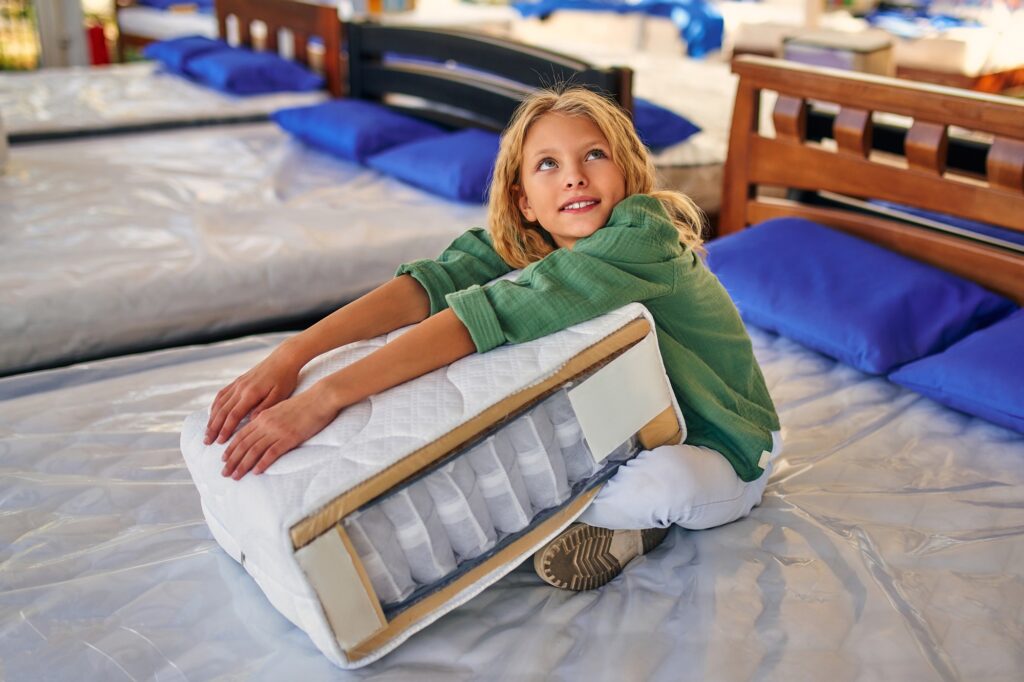Every purchase made online is encrypted with a high level of security you’ve come to expect. Your private information is never shared nor sold, so you can buy with confidence. You can also visit our store if you are in the St. Louis area.

Estimated reading time: 8 minutes
Table of Contents
TL;DR
Choosing the ideal bedding materials is essential for optimal sleep in humid or dry climates. For humid areas, breathable materials like cotton and bamboo wick away moisture and stay fresh. In dry climates, hydrating fabrics like silk and flannel help retain moisture and soothe skin. Techniques like layering, eco-friendly options, and proper care ensure comfort and longevity, creating a perfect sleep environment year-round.
Finding the perfect bedding materials is essential for ensuring comfort and quality sleep, especially when living in regions with challenging climates. Whether dealing with sweltering humidity or arid dryness, choosing ideal bedding materials can make all the difference. Not only do these materials enhance the sleeping experience, but they also contribute to overall health by regulating temperature and managing moisture levels.
This guide will explore how to select bedding suited for your climate, ensuring your bed remains a cozy haven no matter the weather.
Key Takeaways For Ideal Bedding Material
- Climate Impacts Sleep: Humid climates call for moisture-wicking materials, while dry climates benefit from hydration-retentive bedding.
- Top Materials for Humid Climates: Cotton (percale or sateen weaves) and bamboo are breathable and help manage moisture effectively.
- Best Options for Dry Climates: Silk and flannel provide gentle hydration retention, combat dryness, and offer cozy warmth.
- Versatile Materials: Linen works for both humid and dry conditions, offering year-round adaptability.
- Eco-Friendly Choices: Tencel, organic cotton, and bamboo are sustainable and hypoallergenic, enhancing comfort while being environmentally responsible.
Understanding How Climate Affects Sleep
Climate plays a significant role in sleep quality. Humidity can leave you tossing and turning in sticky discomfort, while dry climates may irritate due to dryness. In extreme conditions, improper bedding can exacerbate pain, leading to restless nights and poor sleep hygiene.
Related Links
Bedding acts as the buffer between your body and these external factors, which is why choosing the right materials is crucial. By understanding how climate influences sleep, you can better decide which materials will work best for your needs.
Why Breathable Fabrics Are Key In Humid Climates
In humid climates, bedding needs to manage moisture effectively. Breathable materials like cotton and bamboo are excellent choices. These fabrics wick moisture away from your skin, keeping you cool and dry throughout the night. Cotton, especially in percale or sateen weaves, offers a crisp and airy feel, while bamboo is celebrated for its antimicrobial properties.
With these properties, breathable fabrics help reduce the risk of bacterial growth and odors that are common in humid conditions. Additionally, investing in such materials ensures your bedding stays fresh and comfortable for a longer time.
The Importance Of Moisture Retention In Dry Climates
Dry climates pose different challenges, leaving sleepers with dry skin or irritated airways. Bedding materials like silk and flannel provide gentle comfort while retaining moisture, preventing the excessive loss of hydration. Silk’s smooth texture is particularly soothing for sensitive skin, while flannel’s warmth can combat chilly desert nights.
These materials also create a cozy sleeping environment, reducing the need for excessive layering. Addressing hydration needs and skin sensitivity contributes to a more restorative sleep experience.

Moving To A Humid Area: How To Choose The Ideal Bedding Materials
Relocating to a humid region comes with unique challenges, especially when it comes to maintaining comfort in your new home. Choosing ideal bedding materials ensures you sleep well despite the damp and sticky climate. Materials like bamboo and cotton are excellent options, as they wick away moisture and enhance airflow. Bamboo, in particular, has natural antimicrobial properties, helping prevent odors and bacteria buildup in humid conditions.
When planning your move, partner with a reliable service like Peasley Transfer & Storage, established in 1890. They ensure your bedding and other belongings are transported safely and securely. Their expertise can help you avoid damage caused by humidity during the transition, allowing you to settle into your new environment with ease.
Ideal Bedding Materials For Every Season
No matter the climate, some bedding materials can adapt to seasonal changes. Linen, for instance, is a versatile option that stays breathable in summer and warm in winter. Its natural fibers regulate temperature effectively, making it one of the ideal bedding materials for all-year comfort.
Linen also becomes softer with every wash, increasing its appeal over time. Furthermore, it adds a timeless aesthetic to your bedroom, making it both functional and stylish.
Layering Techniques For Humid And Dry Climates
Layering your bedding is another effective way to adapt to your climate. In humid regions, light layers made of cotton or bamboo provide flexibility, allowing you to adjust to fluctuating temperatures. In dry climates, layering wool blankets over silk or cotton sheets adds warmth and retains moisture without feeling heavy.
This technique allows you to customize your sleeping environment, ensuring comfort throughout the year. It also makes it easier to maintain the longevity of your bedding by reducing wear and tear on any single layer.
The Role Of Thread Count And Weave
Thread count and weave significantly impact how bedding feels and performs in different climates. A lower thread count in a percale weave enhances breathability for humid regions. In dry climates, a higher thread count in sateen weaves provides a softer and denser feel, which helps lock in warmth and moisture. Understanding these factors ensures you’re buying bedding based not just on aesthetics but also on functionality.
Selecting the right thread count and weave can make your bedding feel luxurious while keeping it practical for your climate needs.
Eco-Friendly Options For Climate-Specific Bedding
Sustainable bedding options are not only environmentally friendly but also highly functional. Tencel, made from eucalyptus fibers, is a sustainable material that excels in managing moisture, making it ideal for humid areas. Organic cotton and bamboo sheets are other excellent choices for those seeking eco-conscious and climate-appropriate bedding.
Choosing eco-friendly materials also reduces your carbon footprint, aligning your bedding choices with sustainable living practices. These materials are often hypoallergenic, providing additional benefits for those with sensitive skin or allergies.

Proper Care And Maintenance Of Bedding
Caring for your bedding ensures its longevity and performance. In humid climates, frequent washing prevents the buildup of sweat and bacteria. For dry climates, gentle washing with hydrating fabric softeners keeps bedding fibers soft and prevents cracking. When storing away your bedding, ensure it’s clean and placed in breathable bags.
Proper storage preserves the quality of your ideal bedding materials, preventing mildew or damage from improper handling. This saves money in the long run and ensures your bedding remains in peak condition for years.
Blending Style And Comfort In Bedding Choices
Bedding materials should suit the climate and align with your aesthetic preferences. Neutral tones in linen create an airy, relaxed vibe, perfect for humid climates. For dry areas, plush, rich textures in silk or flannel add a luxurious and inviting touch to your bedroom. Combining style and functionality allows you to create a personalized space that promotes relaxation.
With the right mix, you can transform your bedroom into a sanctuary catering to your needs and tastes.
The Long-Term Benefits Of Choosing Ideal Bedding Materials
Investing in high-quality, climate-appropriate bedding has long-term advantages. Not only does it enhance sleep quality, but it also reduces the need for frequent replacements. Choosing durable and versatile materials, such as linen or bamboo, ensures you’re prepared for changing weather patterns while enjoying a restful night’s sleep.
Over time, this investment pays off in terms of comfort, durability, and even energy savings, as climate-specific bedding can reduce the need for additional heating or cooling.
Prioritize Comfort With Ideal Bedding Materials
Selecting the ideal bedding materials for humid or dry climates is an investment in comfort and well-being. From moisture-wicking cotton and bamboo for humid nights to hydrating silk and flannel for dry environments, your bedding can be tailored to meet the demands of your climate. You can create a sleeping space that promotes relaxation and rejuvenation year-round.
Ultimately, prioritizing your comfort ensures that your bedding supports restful sleep and a healthy lifestyle, no matter where you live.
FAQs For Ideal Bedding Materials
Q: What Bedding Materials Are Best For Humid Climates?
A: Breathable materials like cotton and bamboo are ideal for humid climates. They wick away moisture, enhance airflow, and reduce the risk of bacterial growth and odors.
Q. How Do I Choose Bedding For A Dry Climate?
A: Opt for materials like silk and flannel that retain moisture and provide a cozy, soothing texture. These materials help prevent dryness and skin irritation.
Q. Can I Use The Same Bedding Year-Round?
A: Yes, materials like linen are versatile and adapt to seasonal changes. They stay breathable in summer and provide warmth in winter, making them ideal for year-round use.
Q: What Is The Role Of Thread Count And Weave In Bedding Selection?
A: Thread count and weave impact bedding performance. Lower thread counts with percale weaves are more breathable for humid areas, while higher thread counts in sateen weaves are denser and better suited for dry climates.
Q: How Can I Maintain My Bedding For Longevity?
A: In humid climates, wash bedding frequently to prevent bacteria buildup. For dry climates, use hydrating fabric softeners during gentle washes. Store clean bedding in breathable bags to preserve quality and prevent mildew.
Contact STL Beds Now
You can also contact us by filling out the form below. Make sure to fill in as many fields as possible so we can respond to you with the most accurate information!
